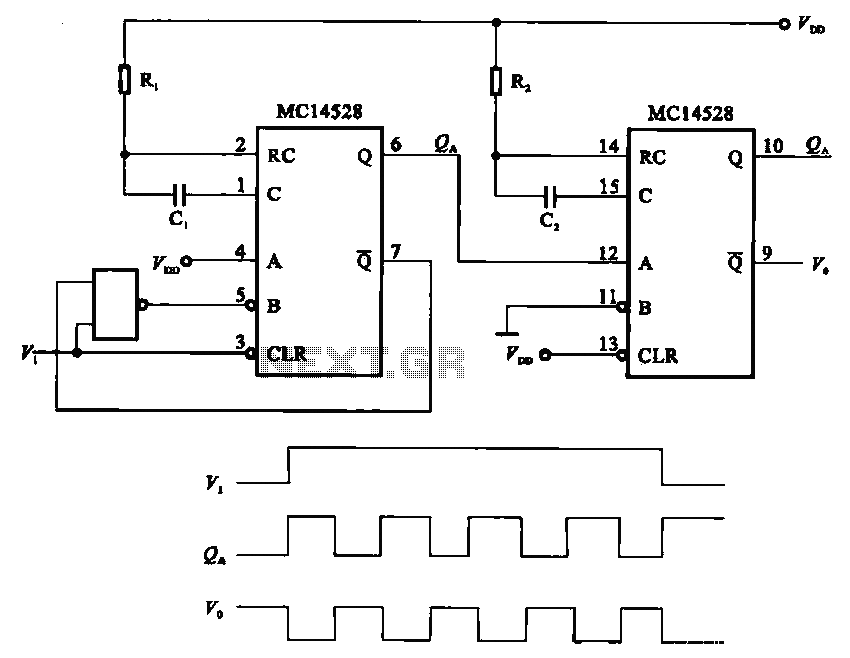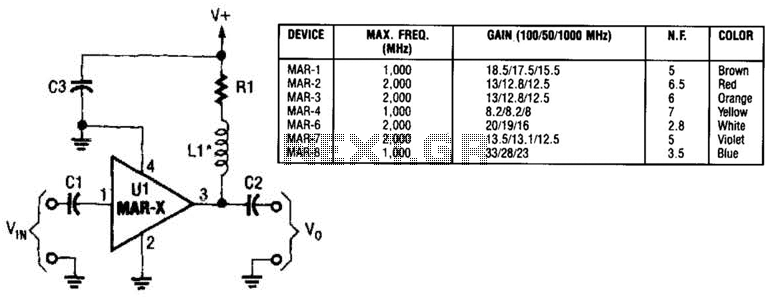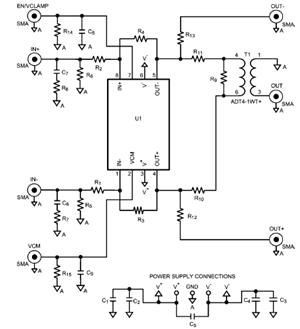
Monitoring by the pulse signal constituting the single-shot generating circuit

The pulse generating circuit monitors signals using monostable flip-flops. It generates a single-shot output signal based on the input pulse signal. A key signal from the monostable flip-flops is represented in a formula, with the input (V1) and output (V0, QA) signal waveforms illustrated in the accompanying figure.
The pulse generating circuit operates on the principles of monostable multivibrators, commonly referred to as monostable flip-flops. This circuit is designed to produce a single output pulse in response to a triggering input signal. The operation begins when the input voltage (V1) exceeds a certain threshold, causing the circuit to transition from its stable state to a temporary unstable state, during which it generates a pulse.
The output of the monostable flip-flop (V0) is characterized by a specific duration determined by the circuit's timing components, typically a resistor-capacitor (RC) network. The timing is crucial as it defines the width of the output pulse (QA), which can be adjusted by varying the values of the resistor and capacitor in the circuit.
In practical applications, the pulse generating circuit can be used in various timing and control applications, such as generating clock pulses for digital circuits, debouncing mechanical switches, or creating specific time delays in electronic systems. The waveform of the input and output signals can be analyzed using an oscilloscope, where the input signal (V1) will show a sharp transition, while the output signal (V0) will display a pulse of defined width corresponding to the circuit's configuration.
The design considerations for such circuits include the selection of the appropriate components to ensure reliable operation across the desired range of frequencies and pulse widths. Additionally, the stability of the circuit can be enhanced by incorporating hysteresis, which prevents false triggering from noise in the input signal.by the pulse generating circuit monitor signal monostable flip-flops Monitoring by the pulse signal constituting the single-shot generating circuit Pulse generating circuit shown in formula a key signal from the monostable flip-flops. Its input (vl) and output (Vo, QA) signal waveform shown in FIG.
The pulse generating circuit operates on the principles of monostable multivibrators, commonly referred to as monostable flip-flops. This circuit is designed to produce a single output pulse in response to a triggering input signal. The operation begins when the input voltage (V1) exceeds a certain threshold, causing the circuit to transition from its stable state to a temporary unstable state, during which it generates a pulse.
The output of the monostable flip-flop (V0) is characterized by a specific duration determined by the circuit's timing components, typically a resistor-capacitor (RC) network. The timing is crucial as it defines the width of the output pulse (QA), which can be adjusted by varying the values of the resistor and capacitor in the circuit.
In practical applications, the pulse generating circuit can be used in various timing and control applications, such as generating clock pulses for digital circuits, debouncing mechanical switches, or creating specific time delays in electronic systems. The waveform of the input and output signals can be analyzed using an oscilloscope, where the input signal (V1) will show a sharp transition, while the output signal (V0) will display a pulse of defined width corresponding to the circuit's configuration.
The design considerations for such circuits include the selection of the appropriate components to ensure reliable operation across the desired range of frequencies and pulse widths. Additionally, the stability of the circuit can be enhanced by incorporating hysteresis, which prevents false triggering from noise in the input signal.by the pulse generating circuit monitor signal monostable flip-flops Monitoring by the pulse signal constituting the single-shot generating circuit Pulse generating circuit shown in formula a key signal from the monostable flip-flops. Its input (vl) and output (Vo, QA) signal waveform shown in FIG.





